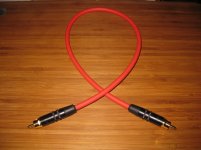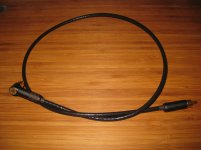Hi!
I want to make my own shielded RCA signal cables, short lengths from DAC to preamp, and from preamp to poweramp. There are probably many threads discussing this, but I am having trouble finding appropriate lengths and deciding cable type.
Can anyone help? Where to buy, and what cable construction types and conductor material is the best way to go? I am thinking cooper, but should I go coaxial or what is most cost effective solution?
It would be nice if it could also be used for internal amp signal wiring.
I appreciate any advice.
Regards,
Andy
I want to make my own shielded RCA signal cables, short lengths from DAC to preamp, and from preamp to poweramp. There are probably many threads discussing this, but I am having trouble finding appropriate lengths and deciding cable type.
Can anyone help? Where to buy, and what cable construction types and conductor material is the best way to go? I am thinking cooper, but should I go coaxial or what is most cost effective solution?
It would be nice if it could also be used for internal amp signal wiring.
I appreciate any advice.
Regards,
Andy
Last edited:
Use Belden RG-59 75ohm coax myself.
9259 is the nicer stuff to work with, soft flexible PVC outer and Polyethlene foam insulator. Can be bought in Black or Red or a variety of other colours.
89259 is more rigid, uses FEP outer and insulator, shiny black exterior.
Both have the same copper conductor and shield, and the same electrical attributes with ~17pf/ft capacitance.
9259 is the nicer stuff to work with, soft flexible PVC outer and Polyethlene foam insulator. Can be bought in Black or Red or a variety of other colours.
89259 is more rigid, uses FEP outer and insulator, shiny black exterior.
Both have the same copper conductor and shield, and the same electrical attributes with ~17pf/ft capacitance.
Attachments
Last edited:
Maybe the Belden 8451? Twisted pair tinned copper with polypropylene insulation. Foil shield and a drain wire. I used this inside my DH-200 lo these many years ago.
Connectors could be the KLEIs (with grommets)
KLEI Classic Harmony Phono/RCA plug
KLEI Grommet for Male RCA Plugs
Just a thought.
Connectors could be the KLEIs (with grommets)
KLEI Classic Harmony Phono/RCA plug
KLEI Grommet for Male RCA Plugs
Just a thought.
Use Belden RG-59 75ohm coax myself.
9259 is the nicer stuff to work with, soft flexible PVC outer and Polyethlene foam insulator. Can be bought in Black or Red or a variety of other colours.
89259 is more rigid, uses FEP outer and insulator, shiny black exterior.
Both have the same copper conductor and shield, and the same electrical attributes with ~17pf/ft capacitance.
Very nice.
Can I ask where you got the connectors/contacts?
Do you want to connect the plugs to a prefab wire (coax or not), or do you want to build the cabe, too?
Mogami 3082 is highly regarded (and 2520 looks and feels very very nice—white/pale rose and very soft), and there is DIY Silver RCA Interconnect Cables
I tried the latter option—rather expensive, but fun. I then tried to „counter-proof“ it and twisted a pair of enameled copper wire—works too...
Mogami 3082 is highly regarded (and 2520 looks and feels very very nice—white/pale rose and very soft), and there is DIY Silver RCA Interconnect Cables
I tried the latter option—rather expensive, but fun. I then tried to „counter-proof“ it and twisted a pair of enameled copper wire—works too...
Last edited:
The neutrik "pro" RCA connectors are nifty: ground connects before line...
https://www.neutrik.com/en/neutrik/products/phono-rca-connectors/profi-cable-connectors
https://www.neutrik.com/en/neutrik/products/phono-rca-connectors/profi-cable-connectors
For analog RCA interconnects, there are many suitable coax cables from major bulk cable manufacturers.
Two primary factors:
a] outside diameter needs to fit the chosen connector.
b] heavy braided shield.
* * * * * * * * *
Save the shielded pair & quad cables for XLR balanced interconnects.
Two primary factors:
a] outside diameter needs to fit the chosen connector.
b] heavy braided shield.
* * * * * * * * *
Save the shielded pair & quad cables for XLR balanced interconnects.
This. Go with the best braided shield (lowest DCR and highest coverage %) you can find, in the size that fits. Nothing else really matters.For analog RCA interconnects, there are many suitable coax cables from major bulk cable manufacturers.
Two primary factors:
a] outside diameter needs to fit the chosen connector.
b] heavy braided shield.
* * * * * * * * *
Save the shielded pair & quad cables for XLR balanced interconnects.
Hum Rejection in Unbalanced Audio Cables -- Blue Jeans Cable
EDIT: Uh, if you don't have good crimping tools, try to stick with connectors that can be soldered.
What do you guys think of this? Double screen.
In stock by the meter:
Mogami 2964 Coaxial, Miniaturkabel, 75 Ohm, O 4,8 mm | cma audio GmbH
What do you think about the DCR? 0R083 per meter inner shield, 0R011 per meter outer shield.
Capacitance a nice low 19pf/feet.
Other things that look good/bad? Is this a go to? Supposed to be super flexible.
2520 is out of stock, but it actually has more capacitance and higher dcr.
In stock by the meter:
Mogami 2964 Coaxial, Miniaturkabel, 75 Ohm, O 4,8 mm | cma audio GmbH
What do you think about the DCR? 0R083 per meter inner shield, 0R011 per meter outer shield.
Capacitance a nice low 19pf/feet.
Other things that look good/bad? Is this a go to? Supposed to be super flexible.
2520 is out of stock, but it actually has more capacitance and higher dcr.
What do you guys think of this? Double screen.
In stock by the meter:
Mogami 2964 Coaxial, Miniaturkabel, 75 Ohm, O 4,8 mm | cma audio GmbH
What do you think about the DCR? 0R083 per meter inner shield, 0R011 per meter outer shield.
Capacitance a nice low 19pf/feet.
Other things that look good/bad? Is this a go to? Supposed to be super flexible.
2520 is out of stock, but it actually has more capacitance and higher dcr.
In stock by the meter:
Mogami 2964 Coaxial, Miniaturkabel, 75 Ohm, O 4,8 mm | cma audio GmbH
What do you think about the DCR? 0R083 per meter inner shield, 0R011 per meter outer shield.
Capacitance a nice low 19pf/feet.
Other things that look good/bad? Is this a go to? Supposed to be super flexible.
2520 is out of stock, but it actually has more capacitance and higher dcr.
Shield resistance seems to be middling but pretty good relative to size; compare it to the ones in the Blue Jeans Cable article I linked above. 0.011 R/m is about 3.35 R / 1000 feet. Not sure if the inner and outer shields are in direct electrical contact but even if so, the DCR would be 2.96 R / 1000 feet. May still work well in your application but you decide if it's good enough vs other factors (cost, flexibility, availability, etc.)
Last edited:
- Home
- Design & Build
- Construction Tips
- DIY shielded signal cables

